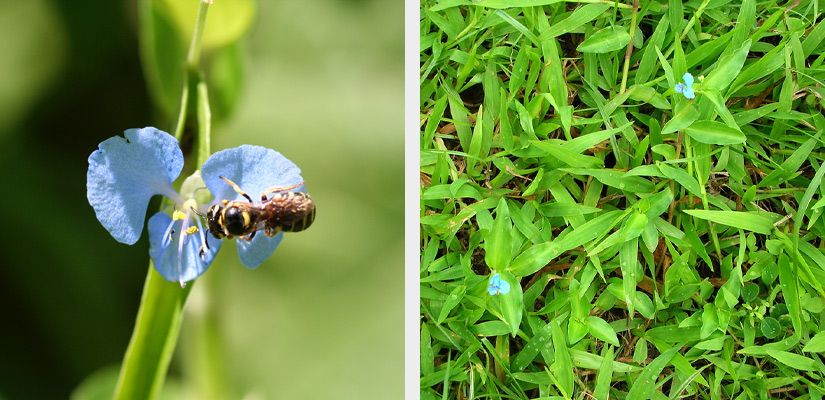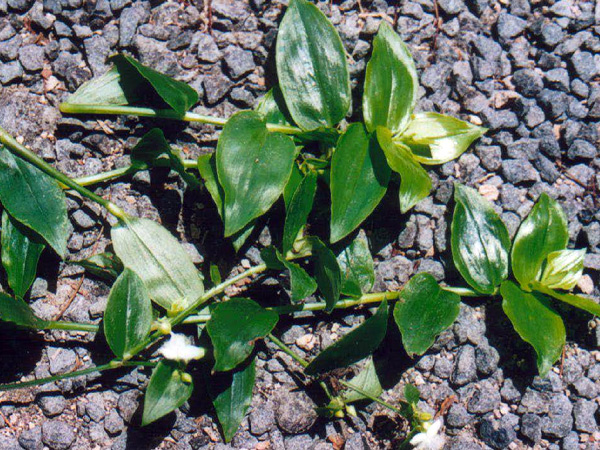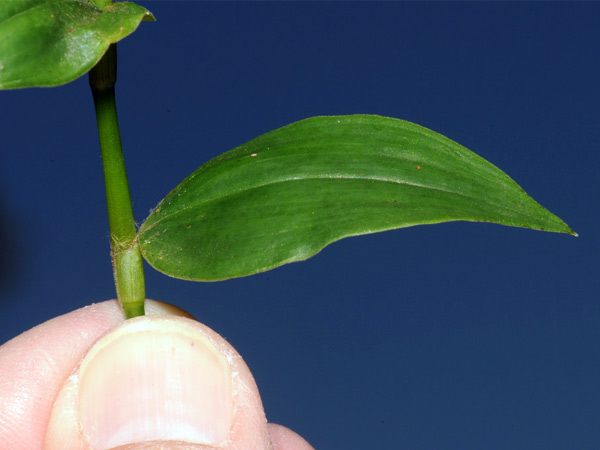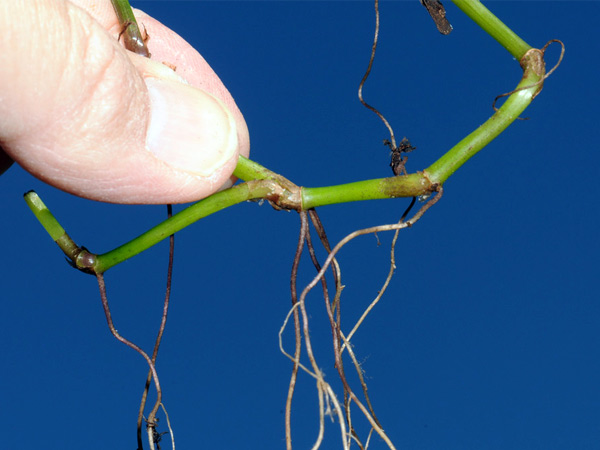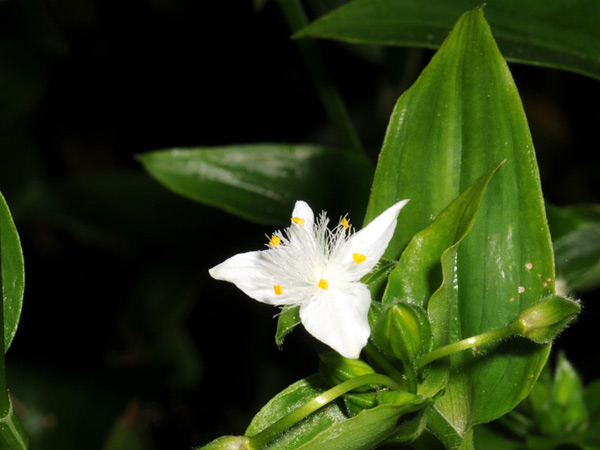Weeds
Trad (Wandering Jew) – Tradescantia fluminensis
Tradescantia fluminensis is a species of spiderwort native to South America. It is one of several plants known by the common name Wandering Jew. It is also known as small-leaf spiderwort, river spiderwort, inch plant, wandering trad, wandering willie, wandering gypsy.[citation needed]
Tradescantia fluminensis is a perennial ground cover that spreads along the ground with soft, hairless stems and leaves. The fleshy stems root at any node that is on the surface. The plant has oval, dark-green leaves with pointed tips that are shiny, smooth and slightly fleshy about 1.25–2.5 inches (32–64 mm) long. The flowers are white with three petals and approx. 0.5–1 inch (13–25 mm) in diameter. They are produced in small clusters in summer but do not produce seeds.
This plant may not be sold, propagated or knowingly distributed (in the Hornsby, Ku-ring-gai, Lane Cove, Manly, North Sydney, Ryde and Willoughby local authority areas).
Profile
Common Names
creeping Christian, green wandering Jew, inch plant, inch-plant, small leaf spiderwort, small-leaf spiderwort, spider wort, spider-wort, spiderwort, trad, wanderer, wandering creeper, wandering Jew, wandering trad, wandering tradescantia, wandering Willie, water spiderwort, white flowered wandering Jew, white-flowered wandering Jew
Origin
Native to South America (i.e. south-eastern Brazil, Argentina and Uruguay).
Cultivation
This species has been cultivated as a garden ornamental, particularly in the cooler and wetter parts of the country. A form with variegated leaves (i.e. Tradescantia fluminensis ‘Variegata’) has been particularly popular in cultivation. It has leaves with white, cream or yellowish-coloured stripes.
Naturalised distribution
Widely naturalised in southern and eastern Australia (i.e. in eastern Queensland, eastern New South Wales, Victoria, Tasmania, south-eastern South Australia and south-western Western Australia). Also naturalised on Lord Howe Island.
Widely naturalised overseas in southern Europe (e.g. Portugal and Italy), the Canary Islands, southern Africa (i.e. South Africa and Swaziland), temperate Asia (e.g. Russia and Japan), New Zealand, the Galápagos Islands, Hawaii and southern USA (i.e. California, Florida, Georgia, Alabama, Louisiana and Kentucky).
Habitat
A weed of forests, forest margins, urban bushland, open woodlands, riparian vegetation, roadsides, ditches, waste areas, disturbed sites and gardens. It prefers damp and shaded areas in temperate and sub-tropical regions, but will also grow in more open habitats and in tropical regions.
Habit
A long-lived (i.e. perennial) herbaceous plant with trailing or creeping (i.e. prostrate or decumbent) stems up to 4 m long. It often grows as a groundcover and forms a dense mat of vegetation.
Distinguishing Features
- a somewhat fleshy long-lived herbaceous plant with trailing stems that produce roots at their joints.
- its shiny leaves have dark green upper surfaces and often slightly purplish undersides.
- these leaves are alternately arranged along the stems and have sheathed bases.
- its white flowers (about 2 cm across) have three pointed petals (7-10 mm long).
- these flowers are borne in small clusters near the tips of the branches.
Stems and leaves
The stems are somewhat fleshy (i.e. semi-succulent) in nature, branched, and produce roots (i.e. adventitious roots) at each of the swollen joints (i.e. nodes).
The glossy leaves are alternately arranged and their bases form short sheaths (5-10 mm long) around the creeping stems. The somewhat fleshy (i.e. semi-succulent) leaf blades (3-6.5 cm long and 1-3 cm wide) are dark green on top and often slightly purplish underneath. They may be either broadly lance-shaped (i.e. lanceolate), egg-shaped in outline (i.e. ovate), or oblong with entire margins and pointed tips (i.e. acute apices). Leaf sheaths can be either hairy (i.e. pubescent) or hairless (i.e. glabrous), while the leaf blades are hairless, or occasionally with some small hairs (i.e. cilia) along their margins.
Flowers and fruit
The flowers (about 2 cm across) are borne in small clusters near the tips of the branches. Each cluster has two small leafy bracts at the base and the individual flowers are borne on stalks (i.e. pedicels) 1-1.5 cm long. They have three white petals (7-10 mm long) with pointed tips (i.e. acute apices), three greenish sepals (6-8 mm long), and six small yellow stamens. Flowering occurs mainly during spring and summer.
The fruit are small capsules, with three chambers. However, this species is not known to produce viable seed in Australia. Black, pitted seeds are produced overseas.
Reproduction and dispersal
This plant only reproduces vegetatively in Australia, by producing roots at the joints (i.e. nodes) of stems that come into contact with the soil (i.e. stolons).
Stem fragments easily break off and may be dispersed by water, vehicles, machinery, in dumped garden waste or in contaminated soil.
Environmental impact
Trad (Tradescantia fluminensis) is a significant environmental weed in Victoria and New South Wales, an environmental weed in South Australia, Queensland and Tasmania, and a potential environmental weed in Western Australia and the ACT. It was recently listed as a priority environmental weed in four Natural Resource Management regions in Australia.
Legislation
This species is declared under legislation in the following states and territories:
- New South Wales: Class 4 – a locally controlled weed. The growth and spread of this species must be controlled according to the measures specified in a management plan published by the local control authority and the plant may not be sold, propagated or knowingly distributed (in the Hornsby, Ku-ring-gai, Lane Cove, Manly, North Sydney, Ryde and Willoughby local authority areas).
- Western Australia: Unassessed – this species is declared in other states or territories and is prohibited until assessed via a weed risk assessment (throughout the entire state).
Similar natives that are not weeds
An introduced species, invasive or non-native species is a species living outside its native distributional range, but which has arrived there by human activity, either deliberate or accidental. These organisms have often been introduced to areas in which they are not native, usually without much regard to the harm that could result.
In many cases there are native plant species that resemble the introduced variety. If you like the look of the introduced species, why not consider an Australian native species with similar aesthetics instead. You will not only have a beautiful garden, you will also be doing something positive for the local flora and fauna.
Trad (Tradescantia fluminensis) can be easily confused with the native aneilema (Aneilema biflorum). It is also relatively similar to native wandering Jew (Commelina cyanea). These species can be distinguished by the following differences:
-
Aneilema biflorum
Aneilema biflorum is a perennial herb in the Commelinaceae family. It grows in moist and shaded places, often near streams in eastern Australia. A ground covering plant, growing to 20 cm tall. White flowers occur between December and March. The wrinkled fruit is flattened, 4 mm long, with pale grey seeds.
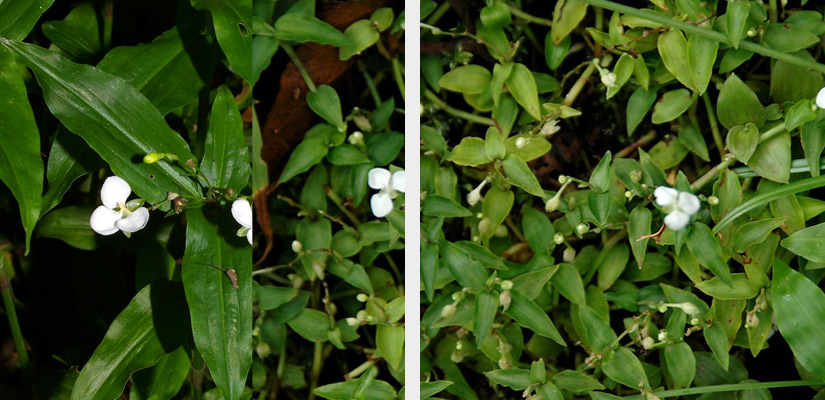
-
Commelina cyanea — Scurvy Weed
Commelina cyanea, commonly known as scurvy weed, is a perennial prostrate herb of the family Commelinaceae native to moist forests and woodlands of eastern Australia,[1] Lord Howe Island and Norfolk Island. The blue flowers appear over the warmer months and are pollinated by bees and flies.
